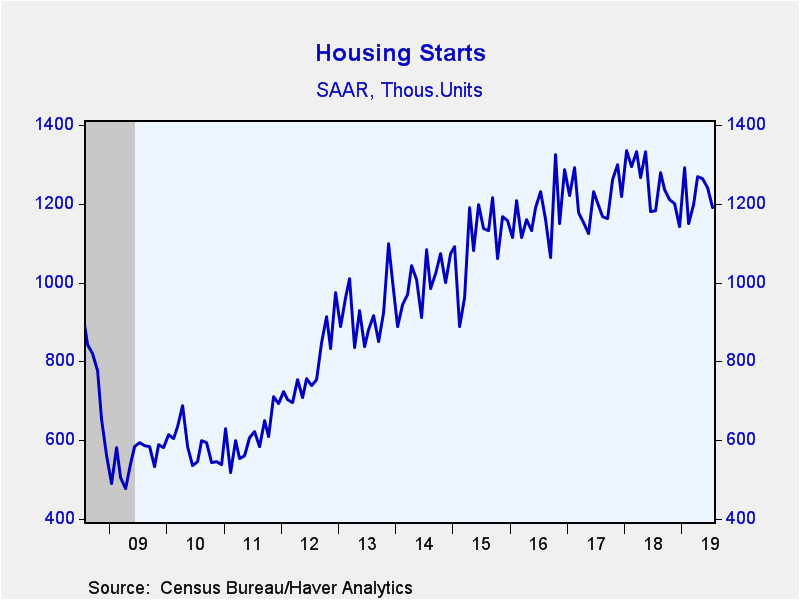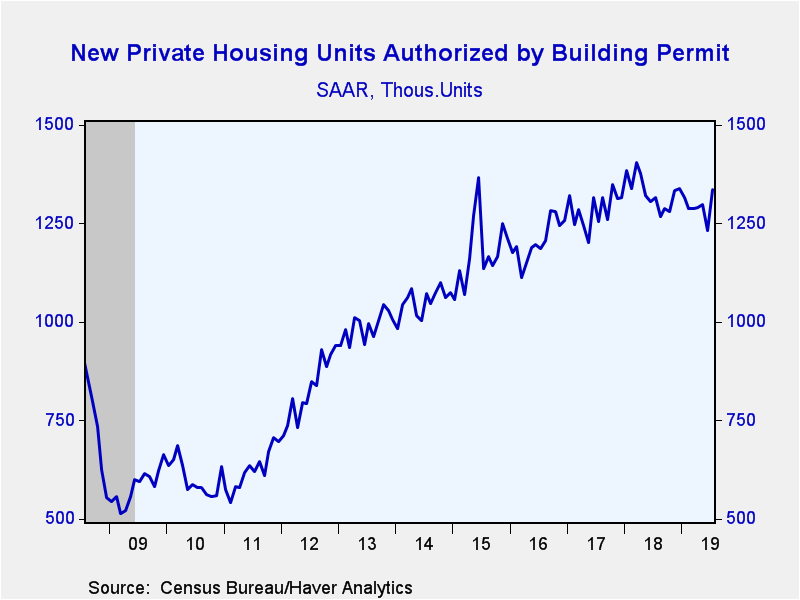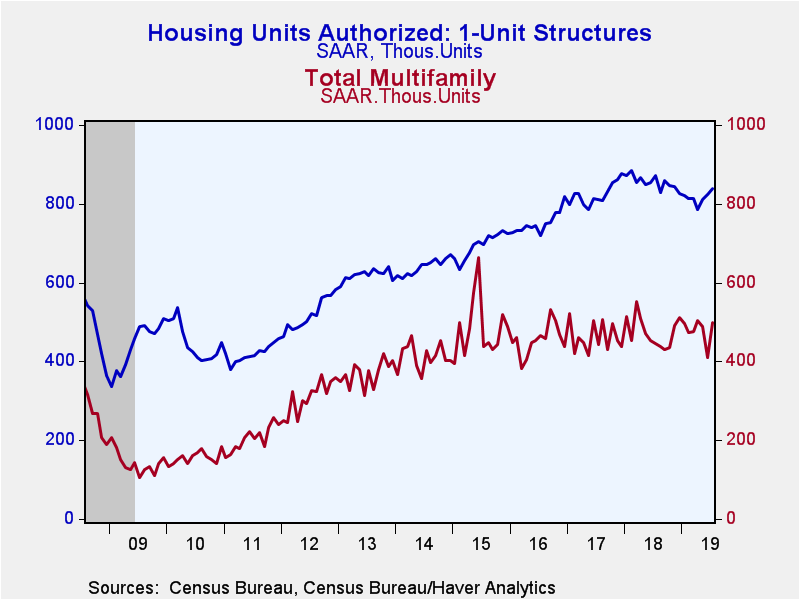 Global| Aug 16 2019
Global| Aug 16 2019U.S. Housing Starts Decline as Multi-family Starts Weaken
by:Tom Moeller
|in:Economy in Brief
Summary
New building activity fell for the third straight month during July. Housing starts declined 4.0% (+0.6% y/y) to 1.191 million (SAAR) after falling to 1.241 million in June, revised from 1.253 million. Starts in May also were revised [...]
New building activity fell for the third straight month during July. Housing starts declined 4.0% (+0.6% y/y) to 1.191 million (SAAR) after falling to 1.241 million in June, revised from 1.253 million. Starts in May also were revised slightly lower to 1.264 million, down from 1.270 million in April. Starts have fallen 10.8% since the peak in January 2018. The Action Economics Forecast Survey expected 1.260 million starts during July.
A drop in starts of multi-family housing units led the total lower during July. They declined 16.2% (-2.8% y/y) to 315,000 from 376,000 in June, revised from 406,000. Countering this decline, starts of single-family homes edged 1.3% higher last month (1.9% y/y) to 876,000 units from 865,000 in June, revised from 847,000.
The decline in housing starts during July reflected weakness across the country. In the Northeast, starts fell by 13.8% (-8.7% y/y) to 94,000 units, after surging 26.7% in June. Starts in the Midwest declined 6.2% (+1.7% y/y) to 181,000, but remained up sharply since a March low. Housing starts in the South fell 4.3% (-4.0% y/y) to 600,000, the lowest level since October 2018. In the West, starts edged 1.3% higher last month to 316,000 (13.7% y/y) after declining for three straight months.
Building permits increased 8.4% last month (1.5% y/y) to 1.336 million from an upwardly revised 1.232 million in June. Permits to build a single-family home rose 1.8% (-3.8% y/y) to 838,000, the highest level in six months. Multi-family building permits surged 21.8% (11.9% y/y) to 498,000 and made up June's sharp decline. Permits data back through 2013 were revised.
The housing starts and permits figures can be found in Haver's USECON database. The expectations figure is contained in the AS1REPNA database.
| Housing Starts (000s, SAAR) | Jul | Jun | May | Jul Y/Y % | 2018 | 2017 | 2016 |
|---|---|---|---|---|---|---|---|
| Total | 1,191 | 1,241 | 1,264 | 0.6 | 1,250 | 1,209 | 1,178 |
| Single-Family | 876 | 865 | 814 | 1.9 | 873 | 852 | 786 |
| Multi-Family | 315 | 376 | 450 | -2.8 | 377 | 357 | 392 |
| Starts By Region | |||||||
| Northeast | 94 | 109 | 86 | -8.7 | 111 | 111 | 116 |
| Midwest | 181 | 193 | 158 | 1.7 | 171 | 180 | 185 |
| South | 600 | 627 | 705 | -4.0 | 631 | 603 | 585 |
| West | 316 | 312 | 315 | 13.7 | 336 | 314 | 292 |
| Building Permits | 1,336 | 1,232 | 1,299 | 1.5 | 1,330 | 1,286 | 1,207 |
Tom Moeller
AuthorMore in Author Profile »Prior to joining Haver Analytics in 2000, Mr. Moeller worked as the Economist at Chancellor Capital Management from 1985 to 1999. There, he developed comprehensive economic forecasts and interpreted economic data for equity and fixed income portfolio managers. Also at Chancellor, Mr. Moeller worked as an equity analyst and was responsible for researching and rating companies in the economically sensitive automobile and housing industries for investment in Chancellor’s equity portfolio. Prior to joining Chancellor, Mr. Moeller was an Economist at Citibank from 1979 to 1984. He also analyzed pricing behavior in the metals industry for the Council on Wage and Price Stability in Washington, D.C. In 1999, Mr. Moeller received the award for most accurate forecast from the Forecasters' Club of New York. From 1990 to 1992 he was President of the New York Association for Business Economists. Mr. Moeller earned an M.B.A. in Finance from Fordham University, where he graduated in 1987. He holds a Bachelor of Arts in Economics from George Washington University.










